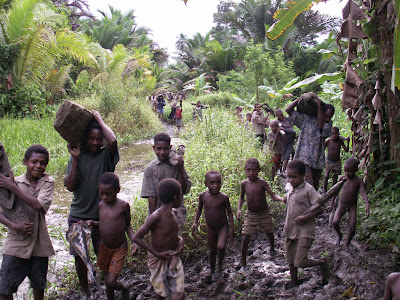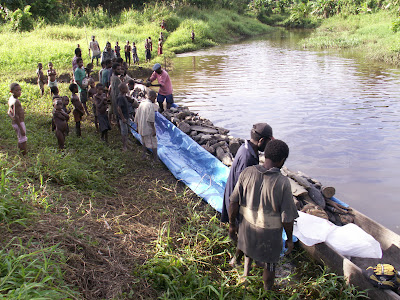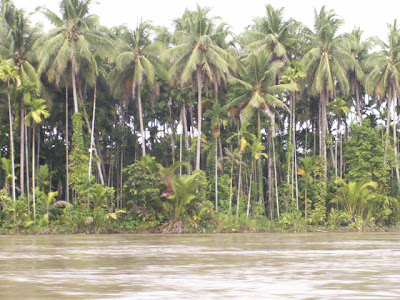 At dawn, boiling water for breakfast
At dawn, boiling water for breakfast 



Muni inseparable from my book, squatting because the ceiling is not high, I review some figures Minja .

Aligning objects before loading them into the canoe

The canoe is ready , covering protect objects from the sun and rain .

A small family landed

Towards Singjuk
In the rainy season, roads are very muddy

Testimony ...
 A houses ceremony Singjuk
A houses ceremony Singjuk  The inner surfaces of the roofs of ceremonial house are covered with bark and often decorated with painted figure of worship, Minja here janus .
The inner surfaces of the roofs of ceremonial house are covered with bark and often decorated with painted figure of worship, Minja here janus .  Here, a statue nogwi
Here, a statue nogwi  Looking outside
Looking outside  On the other box, a crocodile bark was completely reconstituted. Here we see the tail.
On the other box, a crocodile bark was completely reconstituted. Here we see the tail.  And here, his mouth
And here, his mouth  Back to the dugout
Back to the dugout  It's a long parade of children and adults to accompany me and help me carry my acquisitions.
It's a long parade of children and adults to accompany me and help me carry my acquisitions.  Preparation of the canoe
Preparation of the canoe  She is loaded, it's time to start
She is loaded, it's time to start  Knowing that I had to go through this place, some people Urumbanj waiting for me in the river to offer me things.
Knowing that I had to go through this place, some people Urumbanj waiting for me in the river to offer me things.  The canoes are reconciled and it manages to sell and buy
The canoes are reconciled and it manages to sell and buy  women paddling in general sitting
women paddling in general sitting  We to Kupkain in the box where we will spend the night. Notice the painted boards that decorate this place
We to Kupkain in the box where we will spend the night. Notice the painted boards that decorate this place  These boards are almost round the box.
These boards are almost round the box.  A Swagup several men came together to make paddles and canoes
A Swagup several men came together to make paddles and canoes  This woman Swagup extract the "starch of the sago palm pulp
This woman Swagup extract the "starch of the sago palm pulp  Starch is collected in this back canoe
Starch is collected in this back canoe  This starch will be used to bake cakes that serve as sago starch in the diet of people in the Sepik
This starch will be used to bake cakes that serve as sago starch in the diet of people in the Sepik  A Mino, bark baskets are made to protect small pottery
A Mino, bark baskets are made to protect small pottery  Here's another house ceremony, but this time in the village of Yessan
Here's another house ceremony, but this time in the village of Yessan  collection was successful and I have to use two boats joined together by a bamboo bed for transporting a large volume of objects. However, the weight constraint remains and it will monitor the water line of the raft so as not to load too. In case of strong wind, ripples can form quickly, water filling the boat and the boat sank.
collection was successful and I have to use two boats joined together by a bamboo bed for transporting a large volume of objects. However, the weight constraint remains and it will monitor the water line of the raft so as not to load too. In case of strong wind, ripples can form quickly, water filling the boat and the boat sank.  was placed first boards and shields
was placed first boards and shields  Barks painted, fragile, are packed between the bamboos.
Barks painted, fragile, are packed between the bamboos.  We often wonder about the small size of the canoes are on display in our showroom, this photo is all talk.
We often wonder about the small size of the canoes are on display in our showroom, this photo is all talk.  children are associated with many tasks of daily living, for fun and with a smile
children are associated with many tasks of daily living, for fun and with a smile  double canoe fills ...
double canoe fills ... 
It is now sufficiently charged
 Mino A villager carving a figure Kwoma
Mino A villager carving a figure Kwoma  Two double canoes were needed for the objects collected in the upper Sepik and waskuk Hills
Two double canoes were needed for the objects collected in the upper Sepik and waskuk Hills  Step to Ambunti
Step to Ambunti  Both pilots must agree on their speed and direction
Both pilots must agree on their speed and direction  Arrive Pagwa where you're going to have a first shipment by truck to Wewak
Arrive Pagwa where you're going to have a first shipment by truck to Wewak  We pause to remember the picture, it s is a question of my team the top Sepik
We pause to remember the picture, it s is a question of my team the top Sepik  A memorable moment in arriving at Palimbei. I am greeted by drums played on these two huge garamut
A memorable moment in arriving at Palimbei. I am greeted by drums played on these two huge garamut  The bivouac at night. We do heat the water on the fire in this fireplace clay
The bivouac at night. We do heat the water on the fire in this fireplace clay  Aibom A woman working to collect sago flour
Aibom A woman working to collect sago flour  the pulp of the sago palm
the pulp of the sago palm  starch is recovered here in a bark
starch is recovered here in a bark  House ceremonial Aibom
House ceremonial Aibom  The same house ceremony more closely. Poles, huge, carved entirely.
The same house ceremony more closely. Poles, huge, carved entirely.  No, this is not the bank but a river completely blocked by mounds of earth on which floating weeds have taken root. We will have to fight for nearly an hour and a half to overcome these obstacles and achieve Maramba.
No, this is not the bank but a river completely blocked by mounds of earth on which floating weeds have taken root. We will have to fight for nearly an hour and a half to overcome these obstacles and achieve Maramba.  Yuat River. Strange vision of the man perched on a trunk in the middle of the water.
Yuat River. Strange vision of the man perched on a trunk in the middle of the water.  The banks of the river Yuat have countless palm trees that produce the famous betel nut consumed by the Papuans.
The banks of the river Yuat have countless palm trees that produce the famous betel nut consumed by the Papuans.  Once is not custom, we have abandoned the boat for banana boat and go through to Biwat.
Once is not custom, we have abandoned the boat for banana boat and go through to Biwat.  Children of Mendam extract the pulp of a piece of sago palm trunk.
Children of Mendam extract the pulp of a piece of sago palm trunk.  Region Murik lakes near the mouth of the Sepik. The proximity of the sea is hinted at the presence of mangroves, which testify to the existence a mangrove swamp.
Region Murik lakes near the mouth of the Sepik. The proximity of the sea is hinted at the presence of mangroves, which testify to the existence a mangrove swamp.  Murik The lakes are immense, between sea and river, we do not know very well what you sail.
Murik The lakes are immense, between sea and river, we do not know very well what you sail.  The first huts of the village of Karau
The first huts of the village of Karau  A very large box on stilts Karau
A very large box on stilts Karau  These villages in the region while Murik spread length sandwiched between the sea and lakes.
These villages in the region while Murik spread length sandwiched between the sea and lakes.  Karau
Karau  We resume our journey to Darapap, one sees between the two sides a coral reef that marks the border between the lakes and the Bismarck Sea.
We resume our journey to Darapap, one sees between the two sides a coral reef that marks the border between the lakes and the Bismarck Sea.  Darapap
Darapap 
Darapap
 independent Two canoes are needed to visit Murik. A resident of Darapap with us to show us shortcuts to Aramut.
independent Two canoes are needed to visit Murik. A resident of Darapap with us to show us shortcuts to Aramut.  The sea brings us swell. The canoes are not designed for these conditions, we must be careful.
The sea brings us swell. The canoes are not designed for these conditions, we must be careful.  Night falls on Murik
Night falls on Murik  Arrive Aramut
Arrive Aramut  Aramut
Aramut  Aramut
Aramut  Bivouac Aramut evening in the men's house. You peel the sweet potatoes on the menu tonight.
Bivouac Aramut evening in the men's house. You peel the sweet potatoes on the menu tonight. 




